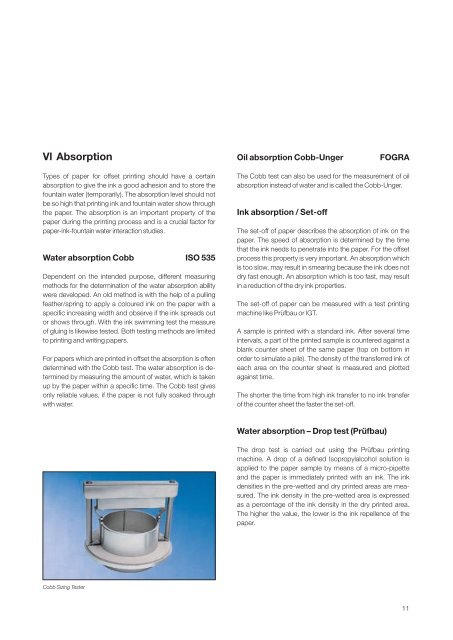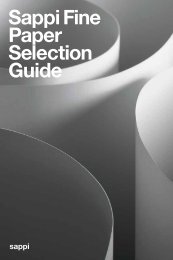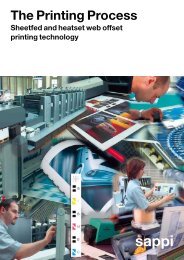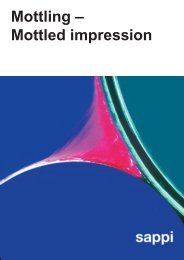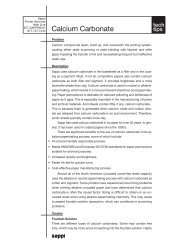Paper Standards Measur Umschlag - Sappi Mobile
Paper Standards Measur Umschlag - Sappi Mobile
Paper Standards Measur Umschlag - Sappi Mobile
Create successful ePaper yourself
Turn your PDF publications into a flip-book with our unique Google optimized e-Paper software.
Vl Absorption<br />
Types of paper for offset printing should have a certain<br />
absorption to give the ink a good adhesion and to store the<br />
fountain water (temporarily). The absorption level should not<br />
be so high that printing ink and fountain water show through<br />
the paper. The absorption is an important property of the<br />
paper during the printing process and is a crucial factor for<br />
paper-ink-fountain water interaction studies.<br />
Water absorption Cobb ISO 535<br />
Dependent on the intended purpose, different measuring<br />
methods for the determination of the water absorption ability<br />
were developed. An old method is with the help of a pulling<br />
feather/spring to apply a coloured ink on the paper with a<br />
specific increasing width and observe if the ink spreads out<br />
or shows through. With the ink swimming test the measure<br />
of gluing is likewise tested. Both testing methods are limited<br />
to printing and writing papers.<br />
For papers which are printed in offset the absorption is often<br />
determined with the Cobb test. The water absorption is determined<br />
by measuring the amount of water, which is taken<br />
up by the paper within a specific time. The Cobb test gives<br />
only reliable values, if the paper is not fully soaked through<br />
with water.<br />
Cobb Sizing Tester<br />
Oil absorption Cobb-Unger FOGRA<br />
The Cobb test can also be used for the measurement of oil<br />
absorption instead of water and is called the Cobb-Unger.<br />
Ink absorption / Set-off<br />
The set-off of paper describes the absorption of ink on the<br />
paper. The speed of absorption is determined by the time<br />
that the ink needs to penetrate into the paper. For the offset<br />
process this property is very important. An absorption which<br />
is too slow, may result in smearing because the ink does not<br />
dry fast enough. An absorption which is too fast, may result<br />
in a reduction of the dry ink properties.<br />
The set-off of paper can be measured with a test printing<br />
machine like Prüfbau or IGT.<br />
A sample is printed with a standard ink. After several time<br />
intervals, a part of the printed sample is countered against a<br />
blank counter sheet of the same paper (top on bottom in<br />
order to simulate a pile). The density of the transferred ink of<br />
each area on the counter sheet is measured and plotted<br />
against time.<br />
The shorter the time from high ink transfer to no ink transfer<br />
of the counter sheet the faster the set-off.<br />
Water absorption – Drop test (Prüfbau)<br />
The drop test is carried out using the Prüfbau printing<br />
machine. A drop of a defined Isopropylalcohol solution is<br />
applied to the paper sample by means of a micro-pipette<br />
and the paper is immediately printed with an ink. The ink<br />
densities in the pre-wetted and dry printed areas are measured.<br />
The ink density in the pre-wetted area is expressed<br />
as a percentage of the ink density in the dry printed area.<br />
The higher the value, the lower is the ink repellence of the<br />
paper.<br />
11


